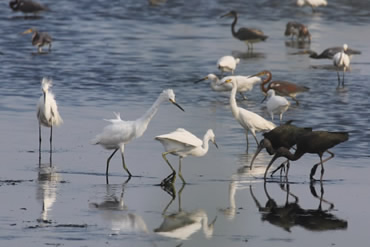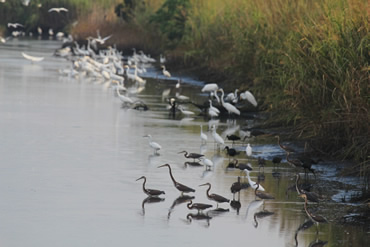Managing Impoundments for Foraging Wading Birds, Shorebirds, and Waterfowl

South Carolina contains approximately 70,000 acres of managed wetlands (Montague et al. 1987). Many of the wetlands in South Carolina are impoundments that are managed to provide food for waterfowl during the winter months. These impoundments are extremely important sources of food for the wading birds that nest in the state. Wading bird populations may be limited by food resources rather than by suitable nesting habitat. It is feasible to manage impoundments in a way that greatly benefits wading birds and shorebirds and also provides excellent habitat for wintering waterfowl.
 Tips for Managing Impoundments to Benefit Wading Birds and Shorebirds
Tips for Managing Impoundments to Benefit Wading Birds and Shorebirds
- Gradually draw down the water-level in impoundments to slowly concentrate prey species (fishes, crustaceans, gastropods, and insects) by removing one spillway riser board at a time or only partially opening the trunk door.
- Stagger drawdowns across different impoundments so prey becomes available throughout the nesting and fledging season.
- Draw down impoundments near nesting colonies during the peak of the nesting season (May – July). This can coincide with widgeongrass grown in brackish marsh or moist-soil management in fresh marsh.
- Draw down impoundments farther from the colonies during peak fledging (July and August), which can encourage the growth of dwarf spikerush.
- Wood storks and ibis require concentrated prey due to their foraging strategies. Draw down impoundments during July to provide food for fledglings when they are most vulnerable to starvation.
More management suggestions can be found in: Management of South Atlantic Coastal Wetlands for Waterfowl and Other Wildlife by Ducks Unlimited (Adobe PDF - file size 9.43MB)
The file above is provided in the Adobe® Acrobat® (PDF) format. Adobe® Reader® is required to open this file and is available as a free download from the Adobe® Web site.


Resources for Landowners and Managers | SCDNR Wading Bird Program
585 Donnelley Dr.,
Green Pond, SC 29446, wadingbirds@dnr.sc.gov

